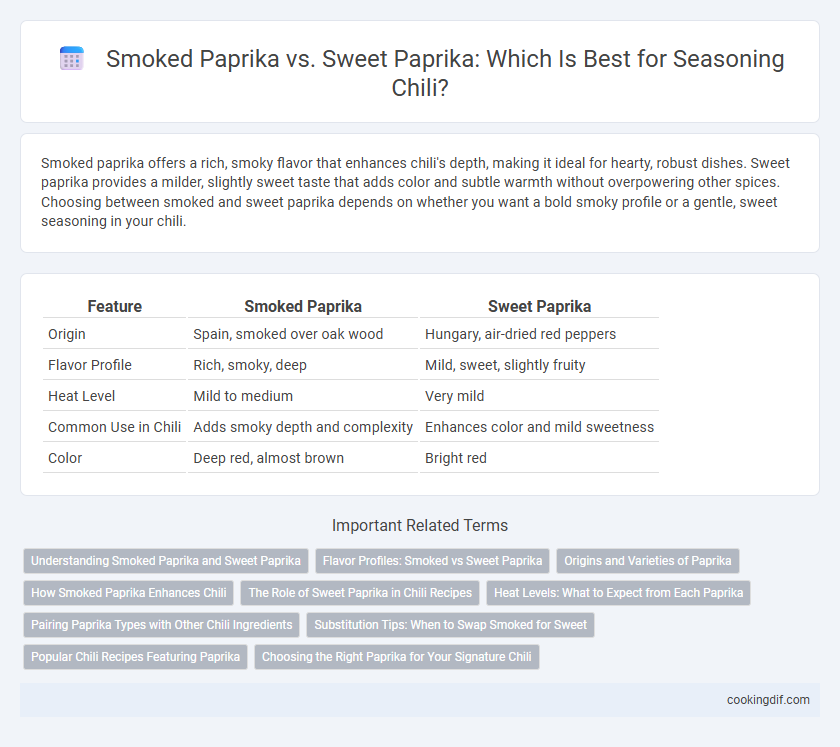Smoked paprika offers a rich, smoky flavor that enhances chili's depth, making it ideal for hearty, robust dishes. Sweet paprika provides a milder, slightly sweet taste that adds color and subtle warmth without overpowering other spices. Choosing between smoked and sweet paprika depends on whether you want a bold smoky profile or a gentle, sweet seasoning in your chili.
Table of Comparison
| Feature | Smoked Paprika | Sweet Paprika |
|---|---|---|
| Origin | Spain, smoked over oak wood | Hungary, air-dried red peppers |
| Flavor Profile | Rich, smoky, deep | Mild, sweet, slightly fruity |
| Heat Level | Mild to medium | Very mild |
| Common Use in Chili | Adds smoky depth and complexity | Enhances color and mild sweetness |
| Color | Deep red, almost brown | Bright red |
Understanding Smoked Paprika and Sweet Paprika
Smoked paprika, derived from dried and smoked red peppers, delivers a rich, smoky flavor with moderate heat intensity, making it ideal for enhancing chili's depth and complexity. Sweet paprika, made from ground sweet peppers without smoking, provides a mild, slightly sweet flavor and vibrant red color, contributing subtle warmth without overpowering the dish. Understanding these distinctions allows precise seasoning choices that elevate chili's taste profile according to desired boldness and aroma.
Flavor Profiles: Smoked vs Sweet Paprika
Smoked paprika delivers a rich, smoky flavor with hints of dried peppers, adding depth and warmth to chili recipes. Sweet paprika offers a milder, slightly sweet taste without smokiness, enhancing dishes with a subtle peppery note. Choosing smoked paprika intensifies the chili's complexity, while sweet paprika maintains a gentle, balanced flavor profile.
Origins and Varieties of Paprika
Smoked paprika, also known as pimenton, originates from Spain and is made by drying peppers over oak wood fires, imparting a rich, smoky flavor ideal for enhancing chili dishes. Sweet paprika, primarily produced in Hungary and Spain, uses air-dried peppers, resulting in a milder, sweeter taste that balances the heat in chilis without overpowering. Both varieties come from Capsicum annuum, but the choice between smoked and sweet paprika influences the depth and aroma of chili seasonings significantly.
How Smoked Paprika Enhances Chili
Smoked paprika enhances chili by adding a deep, smoky flavor that complements the rich, spicy ingredients, creating a more complex and robust taste profile compared to sweet paprika. The smoky notes from smoked paprika intensify the chili's meatiness and add a subtle warmth without overpowering the dish's heat. This seasoning is ideal for chili recipes seeking a smoky depth that elevates the overall flavor experience.
The Role of Sweet Paprika in Chili Recipes
Sweet paprika plays a crucial role in chili recipes by adding a mild, smoky flavor without overwhelming heat, enhancing the overall complexity of the dish. Its natural sweetness balances the spicy elements, creating a well-rounded taste profile that complements tomatoes, beans, and chili peppers. Unlike smoked paprika, which imparts a strong smoky aroma, sweet paprika provides subtle warmth and depth, making it ideal for layering flavors in traditional chili.
Heat Levels: What to Expect from Each Paprika
Smoked paprika brings a mild to moderate heat level with a distinctive smoky flavor profile, making it ideal for adding depth to chili dishes without overwhelming spiciness. Sweet paprika offers very mild heat, serving primarily to enhance color and a subtle sweetness rather than heat intensity. When seasoning chili, choose smoked paprika for a balanced warmth and smoky complexity or sweet paprika for gentle flavor enhancement without noticeable heat.
Pairing Paprika Types with Other Chili Ingredients
Smoked paprika delivers a rich, smoky flavor that enhances the depth of chili dishes, pairing exceptionally well with robust ingredients like ancho chilies, cumin, and smoked meats. Sweet paprika offers a milder, slightly sweet profile that complements the natural heat of jalapenos and the earthiness of beans and tomatoes without overpowering them. Choosing between smoked and sweet paprika depends on the desired flavor intensity and the chili's primary ingredients, balancing smoky warmth with subtle sweetness to elevate the overall taste.
Substitution Tips: When to Swap Smoked for Sweet
Use smoked paprika instead of sweet paprika when you want to add a deep, smoky flavor to chili without altering the spice level. Sweet paprika provides a mild, slightly sweet taste that complements the natural heat of chili, making it ideal for recipes requiring subtle seasoning. Substitute smoked paprika in dishes lacking smoky undertones to enhance complexity, but avoid it if the recipe's profile depends on the clean, sweet flavor of sweet paprika.
Popular Chili Recipes Featuring Paprika
Smoked paprika adds a deep, smoky flavor to popular chili recipes, enhancing the richness of slow-cooked meats and beans often found in traditional Texas chili. Sweet paprika brings a mild, slightly sweet pepper flavor that complements the spices without overpowering, making it ideal for lighter, tomato-based chili dishes. Many chili enthusiasts use a combination of both to balance smoky depth and subtle sweetness, creating a well-rounded seasoning profile.
Choosing the Right Paprika for Your Signature Chili
Smoked paprika imparts a deep, smoky flavor with subtle heat, ideal for chili recipes that seek a robust and smoky profile, while sweet paprika offers a milder, sweeter taste that enhances the natural flavors of chili without overpowering them. When choosing the right paprika for your signature chili, consider whether you want to emphasize smoky complexity or a gentle, sweet undertone to complement your blend of spices, beans, and meat. Using smoked paprika creates a bold, savory chili experience, whereas sweet paprika is perfect for a balanced flavor that lets other ingredients shine.
Smoked Paprika vs Sweet Paprika for seasoning Infographic

 cookingdif.com
cookingdif.com